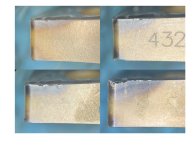Nerdlinger
Stainless
- Joined
- Aug 10, 2013
- Location
- Chicago, IL
Hello Everyone,
I suspect I am getting poor insert life but wanted to run it by y'all as a reality check as well as ask for any help you can offer. The picture shows what all four sides of the insert looks like. One thing I can say is an axial groove is milled into the side of the part and that extends into the beginning of the next part....so half of the turning this insert does is interrupted. On other interrupted cuts in 4140 I have turned the coolant off but for some reason I think doing that here in 4340 would be a bad idea.
Material: Annealed 4340
Insert: Sandvik CNMG432-PM
SFM: G96 S275 (also tried S300...S400 was smokey)
DOC: .200" on first pass, .100" on the second and third (turning 1.125" down to .325")
Feed: .003 IPR
Length of Cut: .500"
Machine: Tsugami B0325-II
Coolant: Swisslube something or other
Life: 50 pcs
Please let me know 1) if you agree that that insert life is short and 2) if you have any ideas to make it last longer. Thank you!
I suspect I am getting poor insert life but wanted to run it by y'all as a reality check as well as ask for any help you can offer. The picture shows what all four sides of the insert looks like. One thing I can say is an axial groove is milled into the side of the part and that extends into the beginning of the next part....so half of the turning this insert does is interrupted. On other interrupted cuts in 4140 I have turned the coolant off but for some reason I think doing that here in 4340 would be a bad idea.
Material: Annealed 4340
Insert: Sandvik CNMG432-PM
SFM: G96 S275 (also tried S300...S400 was smokey)
DOC: .200" on first pass, .100" on the second and third (turning 1.125" down to .325")
Feed: .003 IPR
Length of Cut: .500"
Machine: Tsugami B0325-II
Coolant: Swisslube something or other
Life: 50 pcs

Please let me know 1) if you agree that that insert life is short and 2) if you have any ideas to make it last longer. Thank you!




 )
)

